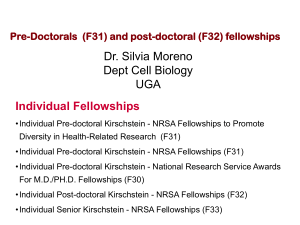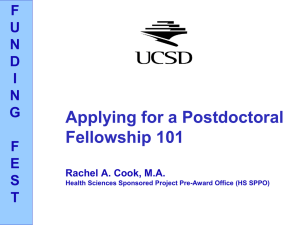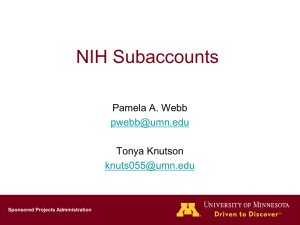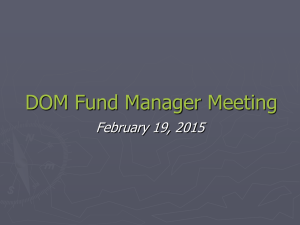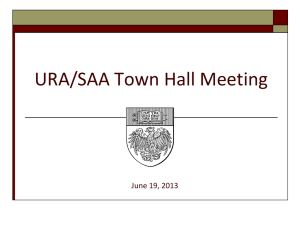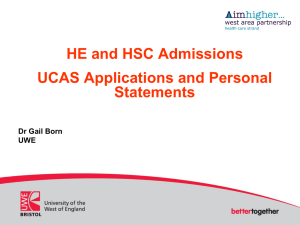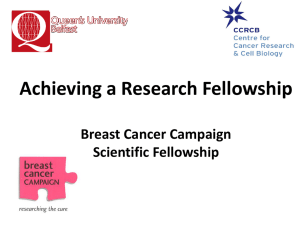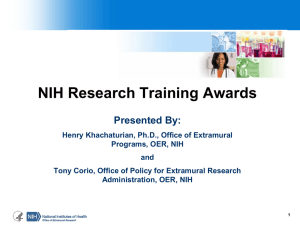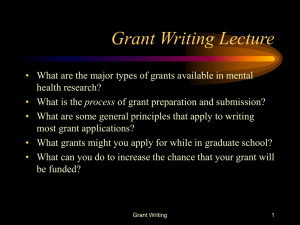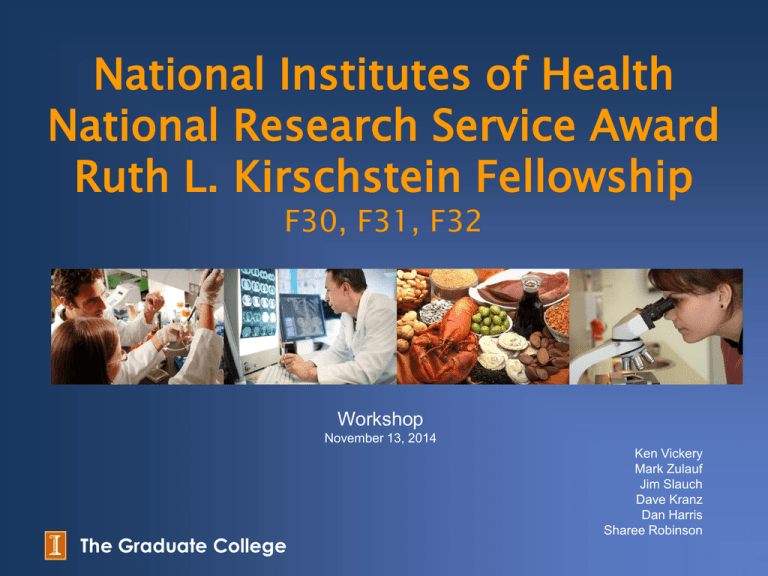
National Institutes of Health
National Research Service Award
Ruth L. Kirschstein Fellowship
F30, F31, F32
Workshop
November 13, 2014
The Graduate College
Ken Vickery
Mark Zulauf
Jim Slauch
Dave Kranz
Dan Harris
Sharee Robinson
NIH/Kirschstein
F30, F31, F32 Pre- and
Postdoctoral Fellowships
-Nuts and BoltsJames M. Slauch
Dept of Microbiology
Medical Scholars Program
November 13, 2014
What are we talking about?
• Individual fellowships from the National Institutes of
Health
• Who’s eligible?
– Must be a US citizen or permanent resident (at
the time of the award)
• Predocs: 5 Years
• MD/PhDs: 6 years including some Med school after
PhD.
• Postdocs: 3 years
– Years funded by other NIH training grants are
subtracted
How to Start
• Give yourself plenty of time ~6 weeks
– More if you project involves animals or humans
Submission
F30 F32
F31
April 8
April 13
August 8
August 13
December 8
Dec 13
Scientific Merit June - July
Review
Advisory
Sept - Oct
Council Review
Oct - Nov
Feb - March
Jan - Feb
May - June
Earliest Project December
Start Date
April
July
Program Announcements
grants.nih.gov/grants/guide/search_results.htm?year=active&scope=pa
• Can be confusing
• F31s
– PA-14-147 Individual PhD Fellowships
– PA-14-148 PhD or MD/ PhD Fellowships for underrepresented minority or disabled students
– PAR-13-127 NINDS MD/PhD Fellowships
• F30s
– PA-14-150 MD/PhD Fellowships
• F32s
– PA-14-149 Postdoctoral Fellowships
– PA-12-261 AHRQ – Healthcare research and quality
How to Start
• Read the Program Announcement CAREFULLY
• Why different PAs?
– Not all Institutes participate in each PA – Institutespecific rules
• Download the Application Instructions
– grants.nih.gov/grants/funding/424/index.htm
– Individual Fellowship Application Guide SF424 (R&R)
– Read it carefully – you don’t need to read it all
• The PA trumps the general instructions
How to Start
• Other useful documents – on the Grad College
Web site
– Power points from today
– Guidance for Preparing and Submitting NIH
Kirschstein Fellowship Applications through
Grants.gov –prepared by OSPRA
– NRSA Fellowship Application Checklist – prepared by
Slauch
How to Start
• Contact your “Grants Administrator” in
your Dept
–Talk to your thesis advisor – who do they
go to when filling out an NIH grant?
• The Grants Administrator should download
the application package and fill out all the
detailed stuff
Register in the ERA Commons
• All PIs (that’s you) need to interact with the
NIH via the “Commons”
• Go to the OSPRA website and click on
“Contact OSPRA”
– Choose “Proposal-Submitting” from the subject
picklist. In the text box – say:
– Please register me as a PI in the ERA Commons
•
•
•
•
UIN
First & Last Name
Date of birth
Email
The Application
• The application is a fancy PDF file
The Application
• The application is a fancy PDF file
There are lots of
directions for each
item
The Application
• Some info is entered directly – the important stuff is uploaded
The Application
• Some info is entered directly – the important stuff is uploaded
Do NOT put page numbers on the PDFs you create, but do put titles
Note that even boxes that are not yellow may be “required”
Letters of Recommendation
• Ask for your letters at least three weeks in advance (a
month’s notice is better).
• Provide your letter writers with a resume as well as a
summary of your research interests. They don’t need
to see the proposal per se.
• The LORs are submitted electronically. Follow the
instruction in section 5.4 of the “Application Guide”.
• You are allowed 3-5 LORs – NOT your advisor.
• You must list the referees BOTH in Item 12 AND in the
cover letter.
Letters of Recommendation
• Send an email to each letter writer. Don’t forget to
attach the reference form.
• Thank you for agreeing to write me a letter of recommendation for my NRSA
application. The due date for my application is [August 8]. The letter must
be submitted via the eRA Commons at:
https://commons.era.nih.gov/commons/reference/submitRefereeInformati
on.jsp
• Please note that you must create a single PDF file that includes the
Fellowship Reference Form that is attached. The additional information you
need is:
– PI Commons User ID: [Your Commons ID]
– PI Last Name: [Your last name]
– Funding Opportunity Announcement Number: [The appropriate PA
number, eg, PA-14-147]
• Full instructions are pasted below: Part B. Instructions for Referees:
Stipend and Tuition Projection
• Your grant administrator will provide a projection of tuition and
fees for the next six years. This will differ depending on your
graduate program.
• You will also need to show this table to the Graduate College
Fellowship Office. Note that this projection is your best estimate
and you are not limited by what you say here. The Univ actually
bills the NIH later based on real costs.
Choose a Study Section
• www.csr.nih.gov/Roster_proto/Fellowship_section.asp
Study
Section
F01-F (20)
Description
F02A-J (20)
Behavioral Neuroscience
KRISTIN KRAMER
F02B-M (20)
Sensory, Motor, and Cognitive
Neuroscience
YUAN LUO
F03A-N (20)
Neurodevelopment, Synaptic Plasticity and MARY SCHUELER
Neurodegeneration
F03B-G (20)
Biophysical and Physiological
Neuroscience
PAEK-GYU LEE
F04-A (20)
Chemistry, Biochemistry, Biophysics, and
Bioengineering
ROSS SHONAT
Etc………
Scientific Review
Officer (SRO)
Brain Disorders and Related Neuroscience VILEN MOVSESYAN
Get Feedback
• Your advisor!
• Others: Fellow students, post-docs,
committee members…
• After your advisor has signed off on it:
– Ken Vickery – Grad College
Application Sign-Off
• Several university officials must sign off on your application
• You must allow sufficient time for each of these entities to act.
• These individuals are not competent to judge the actual
proposal. So although you need a “complete” application to get
signatures, you can continue to make minor edits to the proposal
and upload new PDF files into the master PDF UNTIL it is time to
send it to OSPRA.
• The Grants Administrator should fill out a “Transmittal Form”
• For fellowship applications, the Grad College Fellowship Office
also needs to sign off. This is not explicitly listed on the
transmittal form; rather this is an “other signature if required.”
• Submit completed application that has been reviewed by the
appropriate offices (with help from your Grants Administrator) to
OSPRA (at least 48 hours in advance).
Other Important Points
• This is a “training grant”. The NIH training
record of your thesis advisor matters.
• Ideally, your advisor is:
– Tenured
– NIH Funded
– Has successful PhDs out in the world doing good
• If not, fear not
– Seek out a “co-advisor” that meets the above
criteria
Good Luck!
CONTENT FOR F30/F31
NRSA APPLICATIONS
David Kranz and Dan Harris
Department of Biochemistry
November 13, 2014
Adapted from Lori Raetzman and Paven Aujla, 2012
CHOOSE AN NIH INSTITUTION
MSP website: https://www.med.illinois.edu/MSP/Students/Fellowships/
F30 - PA-11-110 (http://grants.nih.gov/grants/guide/pa-files/PA-11-110.html)
Participating Institutes:
National Cancer Institute (NCI)
National Heart, Lung, and Blood Institute (NHLBI)
National Human Genome Research Institute (NHGRI)
National Institute on Aging (NIA)
National Institute on Alcohol Abuse and Alcoholism (NIAAA)
National Institute of Allergy and Infectious Diseases (NIAID)
National Institute of Arthritis and Musculoskeletal and Skin Diseases (NIAMS)
Eunice Kennedy Shriver National Institute of Child Health and Human Development (NICHD)
National Institute on Deafness and Other Communication Disorders (NIDCD)
National Institute on Dental and Craniofacial Research (NIDCR)
National Institute of Diabetes and Digestive and Kidney Diseases (NIDDK)
National Institute on Drug Abuse (NIDA)
National Institute of Environmental Health Sciences (NIEHS)
National Institute of Mental Health (NIMH)
• Make sure that project fits the institutions mission
• Preparing an application is a very significant
investment of time by you AND your advisor. Need to
be aware of this in determining probability of success.
CORE REVIEW CRITERIA
Major criteria:
Fellowship Applicant
Sponsors and Collaborators
Research Project
Training Plan and Potential
Institutional Environment (necessary, but
usually less critical as a distinguishing factor)
CORE REVIEW CRITERIA
Major criteria:
Fellowship Applicant
Sponsors and Collaborators
Research Project
Training Plan and Potential
Institutional Environment (necessary, but
usually less critical as a distinguishing factor)
APPLICANT IS EVALUATED BY:
Academic credentials: grades, productivity, and
quality of undergraduate institution - candidates
from same school (i.e. UI) may be at disadvantage
Demonstrated scientific accomplishmentpublications, presentations; authorship on peerreviewed paper is useful but not essential
Past funding: e.g. graduate fellowship, or slot on
NIH training grant
Letters of reference (should try to make sure they
are excellent): previous mentors/research advisors;
try to obtain from both undergrad and grad
APPLICANT BIOSKETCH
Standard NIH biosketch format including:
Personal statement: research interests, past
accomplishments, why you can do the proposed
research
Education and employment
Academic and professional honors
Activities and memberships
Publications (peer reviewed papers, if possible)
Length: 2-4 pages
Dan
Fellowship Applicant
“The Kirschstein National Research Award will provide me the
opportunity to master technical training in biochemical research.
In addition, during this award, I will take part in career
development opportunities (i.e. attending conferences, speaking
and poster presentations) to further develop the skills of an
independent scientific-researcher. Ultimately, this training
will prepare me for my goal of becoming a physician-scientist
practicing and conducting research in oncology.”
Dan
DOCTORAL DISSERTATION AND OTHER RESEARCH
EXPERIENCE
Outline previous research experience
Not just techniques learned but questions hypothesized
and answered
Summarize meetings attended, published papers
Length: Two pages
Dan
CORE REVIEW CRITERIA
Major criteria:
Fellowship Applicant
Sponsors and Collaborators
Research Project
Training Plan and Potential
Institutional Environment (necessary, but
usually less critical as a distinguishing factor)
SPONSOR AND CO-SPONSOR CRITERIA
Research support available: grants and funding
sources to your sponsor/advisor
Productivity: publications
Mentoring record: previous and current fellows and
trainees
If your primary sponsor is not strong in all areas,
seek out a co-sponsor. Make sure there is a good
research fit. Make it very “easy” on any co-sponsor
(e.g. by drafting any paragraph they need to
provide, except for their biosketch).
A STRONG, LONG-TIME COLLABORATOR OF
YOUR SPONSOR CAN BE HELPFUL
Could provide evidence of additional methodology
that they are experts in and that you will benefit
from
They could provide additional mentoring
opportunities, e.g. if they are an MD
They could provide evidence of opportunity for
additional training in a more clinical setting
Need Letter of Support and Biosketch from such
collaborator – your advisor/sponsor should draft
such a letter for them
COLLABORATORS
Collaborators at clinical institutions
Reviewers want to know EXACT details about collaboration
“Our lab has a long-standing collaboration with Professor Hans Schreiber at
the University of Chicago, including a program project grant to optimize T
cell therapy in various mouse models. In this subaim, I will work with Prof
Schreiber’s lab to examine both the kinetics of T cell infiltration into tumors,
and the efficacy of treatments (see letter from Prof Schreiber)”
“I will be working in collaboration with members of Dr. Hans Schreiber’s
laboratory at The University of Chicago (see letter from Dr. Schreiber). My
plan is travel to University of Chicago to work with a member of the
Schreiber lab on experiments done with OT-I TCR/RAG-/- and OT-II
TCR/RAG-/-mice, preferably in the summer months. I will also travel to
University of Chicago once or twice a year to present my data at their
lab meeting. This collaboration will not only provide critical feedback on
my project, but will allow me to observe and work at a large academic
medical center.”
Dan
SPONSOR and COLLABORATOR’s BIOSKETCHES
Standard NIH biosketch format including:
Personal statement: research interests, past
research accomplishments (papers, grants),
number of students mentored
Professional experience
Honors and awards
Scientific activities
Selected publications (15 max)
Research support
Length: 3-4 pages
SPONSOR and COLLABORATOR’s BIOSKETCHES
Standard NIH biosketch format to change in 2015:
The new format will allow up to five pages for the entire
biosketch, and researchers will be permitted to
describe up to five of their most significant
contributions to science, the influence of their
contributions on their scientific field, and any
subsequent effects of those contributions on health
or technology. The new format also will allow
researchers to describe their specific role in those
discoveries and to annotate their description with up
to four publications.
CORE REVIEW CRITERIA
Major criteria:
Fellowship Applicant
Sponsors and Collaborators
Research Project
Training Plan and Potential
Institutional Environment (necessary, but
usually less critical as a distinguishing factor)
RESEARCH PROJECT
Specific Aims page:
Disease your research addresses and its impact on
human health: prevalence, cost, morbidity
What is NOT known: e.g. mechanisms of biological
processes that impact the disease; how to design
targeted therapeutic
Your research question/hypothesis
Brief summary of preliminary data: how it fits into
question and what is known
Specific Aims: experimental design to test hypothesis
Length: One page
SPECIFIC AIMS
EXAMPLE
Specific Aim 1. To develop a high affinity TCR against Survivin/HLA-A2
using directed evolution and affinity maturation.
Specific Aim 2. Test high-affinity TCRs in the CAR format for targeting
T cells against Mart1, WT1 and Survivin antigens in vivo.
Specific Aim 3. To develop a method for rapid isolation of high-affinity
TCRs using a universal scaffold.
Dan
RESEARCH PROJECT
Background and significance
What is the major question
Relevance to human health
What will be accomplished if aims are achieved
How will these studies change the field
How is this approach innovative
Preliminary studies
Detailed explanation of figures and results: how they fit
into research question and lead to hypothesis
Research approach: expand on aims
Overview, rationale and design of each aim
Anticipated results, potential pitfalls and alternative
approaches
Length: Six pages
Dan
RESEARCH PROJECT
NCI Mission Statement:
“The National Cancer Institute coordinates the National Cancer Program,
which conducts and supports research, training, health information
dissemination, and other programs with respect to the cause, diagnosis,
prevention, and treatment of cancer, rehabilitation from cancer, and the
continuing care of cancer patients and the families of cancer patients.”
“Research Training Plan:
Many studies have shown that infiltration of tumors with T cells correlates with
improved prognosis (e.g. ref (2)). Therefore, methods that improve T cell
recognition of cancer antigens and infiltration of T cells into tumors will
have high therapeutic potential.”
Dan
RESEARCH TRAINING PLAN TIPS
Break up sections with headings
-Use bold, italics, underlining to emphasize points
Don’t fill up all the available space
-Leave blank lines between sections if you can
A picture is worth a thousand words
Your advisor/sponsor should provide advice and
examples of previous grants
Dan
PROJECT SUMMARY
Significance of project and relevance with to human
health
Brief description of what is known about the
question you are addressing
How your proposal will address unknown aspects
and connect to human health
This is published on a public NIH database
Length: 2 paragraphs
Dan
PROJECT NARRATIVE
Very brief description of question you are
addressing
What results from your proposal will add to
knowledge about particular disease or question
Lay person should be able to understand
Length: One or two sentences
Dan
CORE REVIEW CRITERIA
Major criteria:
Fellowship Applicant
Sponsors and Collaborators
Research Project
Training Plan and Potential
Institutional Environment (necessary, but
usually less critical as a distinguishing factor)
TRAINING PLAN
Seminars and courses: taken and planned
Mentoring: how often will you meet with your sponsor and
collaborators, what you will glean from these meetings
Scientific meetings: attended and planned
Department/program info: prestige of faculty/department,
seminars available to attend; when will you present in
addition to group meetings (e.g. annual departmental
presentations)?, student support activities
Medical Scholars Program (F30 applicants): history and
success of the program; annual symposia; meetings
Specific information about sponsors: how their
background, facilities and equipment will guide your training
Applicant qualification and potential for a research
career: each sponsor should write a short “letter of
recommendation”– pull together how their training and
expertise will guide applicant training
Length: Six pages
GOALS FOR FELLOWSHIP TRAINING AND
CAREER
Define applicant career goals
Relate to research proposed
How will training plan assist and guide applicant
career goals
Use specifics: techniques used, unique university
or program environment that will foster applicant
goals; opportunities for exposure to clinical
mentors?
Length: One page
Dan
ACTIVITES PLANNED UNDER AWARD
Can use a timeline to outline which aims will be
accomplished during which academic years
F30 applicants: can explain percent of time that will be
devoted to research/courses and clinical training
throughout the proposal timeline
Should include meetings, workshops, seminars
Anything that will impact and benefit applicant training
and exposure (keep career goals in mind)
Length: One page
Dan
ACTIVITES PLANNED UNDER AWARD
Explanation of MSP program (most reviewers familiar
with MSTP programs)
Outline exactly when you will take M1 courses and how
you will split up your time (make sure it is reasonable)
Clinical work during PhD
Year
First
Second
Third
Fourth
Fifth
Sixth
Research
Course Work
Clinical
80%
80%
80%
95%
10%
10%
15%
15%
15%
0%
90%
0%
5%
5%
5%
5%
0%
90%
Dan
TRAINING POTENTIAL
“The College of Medicine offers a Clinical Practice Preceptorship (CPP)
course, which I have taken previously and will continue to take during my
graduate studies. The purpose of this program is to maintain a clinical
presence during one’s graduate work. Students are paired with local
practicing physicians and get to experience clinical medicine a minimum of
four times throughout the year. In the past, I have been paired with a
practicing oncologist/hematologist and had the opportunity to observe a
variety of patients with diverse malignancies. I intend on continuing to work
with this physician throughout my graduate studies. Additionally, there is a
student run clinic, HeRMES, which I have volunteered for previously. I
plan on continuing my volunteer work with HeRMES to not only gain clinical
experience but also to provide basic healthcare needs to those in the local
community.”
Dan
CORE REVIEW CRITERIA
Major criteria:
Fellowship Applicant
Sponsors and Collaborators
Research Project
Training Plan and Potential
Institutional Environment (necessary, but
usually less critical as a distinguishing factor)
FACILITIES AND OTHER RESOURCES
List (in outline form) the facilities available to you
during your training
Ex: Common lab facilities: list all common equipment
including centrifuges, microscopes, data processing
equipment
Core facilities: histology, sequencing, flow cytometry
Your advisor probably has “boiler plate” documents for
these
Length: One page (depends on resources)
SELECTION OF SPONSOR AND INSTUITION
Prestige and reputation of university and applicant’s
affiliated program
How selection of university/program fits into applicant
research interest and training plan for future career
How sponsor’s research program and field of expertise
fits exactly your goals
Length: One page
OTHER CONTENT
Resource sharing plan
Ex. Any regents or animals planned to be shared in
studies proposed – a couple of sentences (get this from
your sponsor)
Letters of support from collaborators
Offer help with a technique or training, need biosketch
STUDY SUBJECTS
VETEBRATE ANIMALS SECTION (if applicable it
is mandatory)
Species/strains/ages/sex/number used
Complete description of proposed procedures
Justification: choice of animal, animal number (detailed
breeding plan for transgenic mice)
Description of vet care
Procedures to minimize discomfort
Methods of euthanasia etc.
HUMAN SUBJECTS SECTION
RESPONSIBLE CONDUCT OF RESEARCH
Training
plan for NIH ethics requirement
Ex.: If plan to take or have taken MCB ethics course
requirement, outline topics covered and how they
were covered (texts read, exercises etc.)
List
any other possible ethics courses, workshops
or ethics discussions or mentorship with sponsors
Length: One page
RESPECTIVE CONTRIBUTIONS
Delineate
applicant role in obtaining preliminary
data generated for proposal vs. others
Applicant
role in preparing grant application
Length: One page


